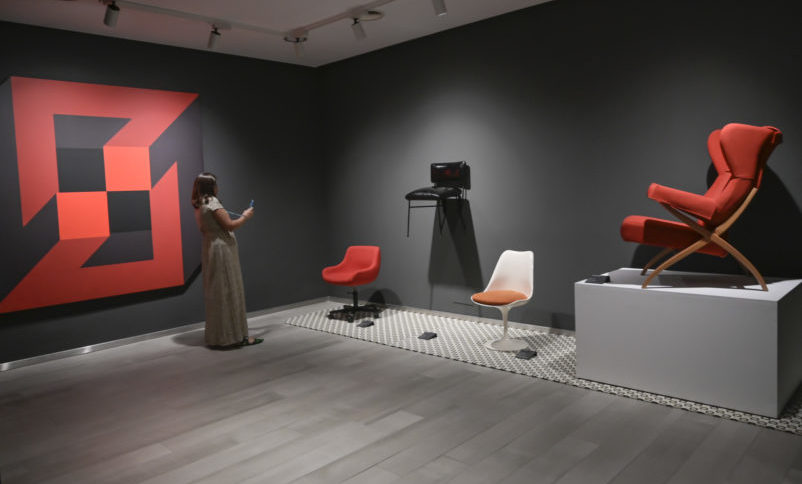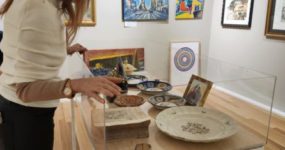Fundación Bancaja presents the exhibition ‘El diseño y la modernidad. Pioneers of design in the Valencian furniture industry (1898-1986).’ The exhibition offers a chronological journey through some of the milestones that marked the origin and evolution of an industrial activity that, from València, became an international reference throughout the 20th century thanks to the best design.
This week, the Bancaja Foundation presented the exhibition ‘El diseño y la modernidad. Pioneers of design in the Valencian furniture industry (1898 – 1986)’, held within the framework of World Design Capital Valencia 2022, which offers a chronological journey through some of the milestones that have marked the origin and evolution of an industrial activity that from València became an international reference throughout the twentieth century regarding the best design. The presentation was attended by the president of the Bancaja Foundation, Rafael Alcón; the president of the Fundació del Disseny de la Comunitat Valenciana, Vicent Martínez, and the curator of the exhibition, Xavier Giner.
The exhibition starts from the beginning of the industrialisation process in furniture in the late 19th century, when some Valencian industrialists became pioneers of design with the development of their own product in a context in which the transition from artisan to industrial activity in Spain was based on the strategy of copying or reproducing foreign references. This was the case of Ventura Feliu, Juan Martínez-Medina, GASISA, Mariner, Mariano García, José Martínez Peris, Federico Giner and José Pons Pedro, among others.
The exhibition route moves on to the first attempts at modernisation between 1955 and 1970 with the arrival of modern design in Spanish society and in the furniture industry through naval interior design, which was also a space of connection with the artistic avant-garde with creators such as Michavila and Alfaro. The opening up to Europe and the USA in the 1960s meant the recovery of contact with international design and the beginning of the path towards modernisation through the business ventures and the work as designers of Rafael García and José Martínez-Medina.
The triumph of design is the focus of the final section of the exhibition with a review of its important development between 1970 and 1986 based on the opening towards Europe and the impulse of personal vocations focused on design with young creators who joined the previous generation such as Xavier Bordils, Grupo Nuc (Lola Castelló, Vicent Martínez, Daniel Nebot and Luis Adelantado), José Miguel Martínez-Medina, Grupo Caps i Mans (Eduardo Albors, José Juan Belda, Jorge Luna and Carlos Albert), among others.
The exhibition brings together 56 emblematic pieces of Valencian furniture and more than 60 documents (posters, drawings, plans, sketches, catalogues…), which bear witness to the fruitful alliance between design and the Valencian furniture industry over nine decades. These pieces coexist in the exhibition with works by Valencian artists who were directly or indirectly related to the sector, such as José María Yturralde, Manuel Hernández Mompó, Andreu Alfaro, Joaquín Michavila, Vicente Ortí, Amadeo Gabino Úbeda. Also on display are works by poster designers such as Josep Renau, Vicente Canet, Molina Gallent, Ruperto Sánchez and Álvaro Miralles.
The group of pieces on display, including some from the Bancaja Foundation collection, come from lenders such as the Arxiu Valencià del Disseny, Fundació Caixa Vinaròs-Espai Corbat, Museo Nacional de Artes Decorativas, Autoridad Portuaria de Valencia in deposit-in deposit Cátedra Demetrio Ribes, Familia Pons/Empresa Point, Federico Giner, Jordi Esteve, José Miguel Martínez-Medina, Julio Vives, Lola Castelló, Mariner, Vicente Martínez Medina, Vicente Ortí Mateu, Vicente Serrano and Xavier Bordils.
On the occasion of the exhibition, a catalogue has been published with reproductions of the pieces on display and texts by design experts such as Xavier Giner, Manuel Lecuona, Julio Vives, Manuel Martínez Torán, Jordi Esteve and Chele Esteve. As part of its cultural and artistic mediation programme, the Bancaja Foundation will develop school workshops to bring the exhibition closer to pupils in the final year of infant, primary, secondary and high school education. Complementary activities also include workshops aimed at people with disabilities and people at risk of social exclusion.
The exhibition will remain at the headquarters of the Bancaja Foundation in Valencia from 23 September to 27 November 2022.
MORE INFORMATION
The Valencian furniture industry was born from the transformation of cabinetmaking workshops into more complex production structures at the end of the 19th century, which allowed them to sustain short series production of models based on catalogues that included the dominant styles for the domestic market of foreign products. In this context of copying or reproduction, pioneers of design in the Valencian furniture industry are considered to be those industrialists who took the risk of developing their own products: this was the case of Ventura Feliu, Juan Martínez-Medina, GASISA, Mariner, Mariano García, José Martínez Peris, Federico Giner and José Pons Pedro, among others.
Crisis and opportunity: the origins of the furniture industry
One of the consequences of the end of the colonial system was a profound crisis in society, culture and the productive fabric, which shook Spain in the second half of the 19th century and marked the turn of the century with pessimistic overtones. Only modernism would take on a certain air of confidence in the future in that tragic and desolate Spain of Unamuno, Baroja and company. But that crisis was also the occasion for some opportunities, for example, with the return of the Indianos who came back loaded with new knowledge and experiences that they quickly transformed into new industries and new ways of doing things. Or those who ventured out to Europe and returned with innovative technology and processes, as was the case with bent furniture.
The first attempts at modernisation (1955-1970)
The Civil War marked a radical break in the modernisation of Spain. The anti-modern and traditionalist character of Franco’s regime, together with the economic autarchy, resulted in the severing of connections with the outside world. Historicist, traditionalist-inspired furniture was the main reference of the period 1939-1959.
Naval interior design, a driving force for modernisation
However, naval interior design was the true gateway to modern design in Spanish society and in the furniture industry. From the 1950s onwards, the Martínez-Medina company carried out intense work for the Spanish naval industry, especially for Unión Naval de Levante (UNL) and the Trasmediterránea company. This work brought them into contact, through the Italian architect and designer Gustavo Pulitzer, with Arflex, and therefore with Italian design, which they began to produce and market for Spain.Naval interior design was also a space of connection with the artistic avant-garde: Joaquín Michavila and Alfaro, among other artists of the Valencian avant-garde, painted the murals on the UNL ships.
International design makes its way
Products under licence from international brands were iconic products, very well designed by world-class designers who began to circulate in Spain in the early 1960s as a sign of a new modernisation, still timid and incipient. This was the case, for example, of the Martínez-Medina family with Arflex or Tecno, but also of Rafael García, who produced and marketed the Herman Miller and Knoll Associates brands for Spain.
Pioneers of modernisation
This opening towards Europe and the USA meant the recovery of contact with international design and was also the first moment of modernisation both in domestic spaces and in work and leisure spaces, thus marking the opening towards modernity in our country in the 1960s. This movement of reconnection with modernity was not without deep resistance, without enormous mistrust.
The Triumph of Design (1970-1986)
In the 1970s, tourism became the country’s leading industry and a driving force for modernisation and social and territorial transformation. The “European” became a positive value; the “foreign” a desirable value. A new generation of young people was agitating non-conformist views throughout Europe and also in Spain. This role of design as an engine of cultural change and an agent of economic development signified a first “triumph” of design. The first policies to promote design were launched at the end of the 1970s through the Valencia Chamber of Commerce and Feria Valencia, marking the end of that condition of “pioneers”, that is to say, solitary adventurers who successfully explored new territories.
Design, a driving force for social and cultural change
Design served to shake off the stigma of the sacrosanct Hispanic difference, going from being an agent of economic development in the 1960s to a driving force for social and cultural change in the 1970s. Being attentive to what was happening outside our borders became a necessity for the restless young people of the time. Experimenting, discovering, questioning models of behaviour, ways of being, became a requirement. Domestic, work and leisure spaces were radically transformed.
A new generation of designers
A small group of young designers joined the previous generation: Xavier Bordils, the Nuc Group (Lola Castelló, Vicent Martínez, Daniel Nebot and Luis Adelantado), the Caps i Mans Group (Eduardo Albors, José Juan Belda, Jorge Luna and Carlos Albert), José Miguel Martínez-Medina, among others. In the 1980s, design and modernity ceased to be a matter of a few and became a material force for social, cultural and economic transformation.
COMPANY RELATIONS
Arflex / Martínez Medina – Basté – Chamber of Commerce of Valencia – Coopmoble – Curvadora Valenciana – Darro – Expormin – Famosa – Federico Giner – García Simón Hermanos – Hijos de Joaquín Lledó – Hijos de Mariano García – JMM – José Martínez Peris – José Martínez-Medina – José Pascual Crespo – Juan Martínez Medina – Julio Benedito Verdet – Knoll / Rafael García -Lansar – Luis Suay – Mariner – Muebles Martínez-Medina – MCM / Martínez-Medina – Mocholí, Pascual y Cía – Palacio del mueble – Pam i Mig – Payá – Pelegrín Tapizados – Point – Punt – Rafael García – Ramón Giménez – Ramón Ricart Gil – Requeni Iluminación – Strassle / Martínez Medina, Tecno / Martínez Medina, Unión Naval de Levante, Ventura Feliu, Vicente Crespo, Vicente García Miralles.
LIST OF DESIGNERS
Tito Agnoli – Franco Albini – Eduardo Albors -Estudio BBPR – José Juan Belda – Xavier Bordils – Cap i Mans – Javier Carvajal – Lola Castelló – Ventura Feliu – Rafael García – Eugenio Gerli – Grupo Nuc – Enrique Mariner – Vicent Martínez – Juan Martínez-Medina – José Martínez Peris – José Martínez Medina – José Martínez Peris – Tecno / Martínez Medina, Tecno / Vicente Crespo, Vicente Crespo, Vicente García Miralles. Medina – José Martínez Peris – José Martínez-Medina – Vicente Martínez-Medina – Sergio Mazza – Paul McCobb – Paco Muñoz – José Pons Pedro – Antonio Ramos – Alberto Roselli – Eero Saarinen – Paul Tuttle – Marco Zanuso
Report by ’24/7 Valencia’
Article copyright ’24/7 Valencia’
‘El diseño y la modernidad. Pioneers of design in the Valencian furniture industry (1898 – 1986)’
23 September to 27 November 2022
Fundación Bancaja
Bancaja Foundation
Plaza de Tetuán, 23
Valencia
Tuesday to Sunday: from 10am to 2pm and from 4.30pm to 8.30pm.
Mondays closed, except for public holidays and the eve of public holidays.
Exhibition visiting rules.
Admission:
General admission: 7 euros. Reduced: 4 euros (pensioners, unemployed, people with disabilities, students aged 13 to 26). Free (under 12s). Tickets on sale at the box office (Plaza Tetuán, 23).
Each ticket allows access to all exhibitions currently on show at the Fundación Bancaja. Tickets purchased in the morning are valid until 2 pm and those purchased in the afternoon until 8:30 pm.
More info: https://www.fundacionbancaja.es/
Related Post
This site uses Akismet to reduce spam. Learn how your comment data is processed.

























Leave a comment